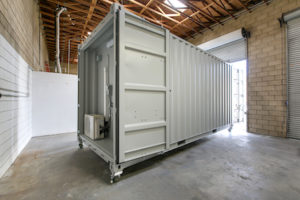Container SCIFs or SAPFs, made by building out ISO shipping containers, can be the best option for an ICD 705 facility if your priorities are speed, simplified acquisition or relocatability.
While SCIFs and SAPFs are often housed in traditional buildings, these will not meet the needs of every program. If you lack space or need to be able to relocate a facility easily, or only need a small amount of space for your program, a container SCIF or SAPF may be your answer.
A container SCIF is a secure facility where you can process, store or discuss classified information like a regular SCIF, but it’s typically smaller in size and can oftentimes be transported using traditional methods. These containers can be used as briefing rooms, workstations, conference rooms, server rooms, and storage. People tend to choose container SCIFs if they need a secure space but have run out of room in their current facility, or if they need a secure space that isn’t permanent, as in it can be relocated while maintaining its accreditation.

Construction of a Container SCIF
Container SCIFs are built inside of an ISO shipping container. An ISO shipping container is a standard shipping container that you would see on the back of boats, trucks, etc. You can take one of these containers/units and retrofit them to meet the ICD/ICS 705 standards and earn accreditation to house a classified program inside the space.
The containers are typically built off-site, and then transported to the client facility before they’re accredited.
They come in standard 20-foot and 40-foot sizes and are built relatively the same as traditionally constructed SCIFs because they have to follow the same construction specifications laid out in the ICD 705 Tech Spec and are held to the same standards in order to be accredited, including acoustic protection, physical hardening, TEMPEST standards and electrical security. The container SCIFs are tested the same way and must perform the same way as a traditional ICD 705 facility, just on a smaller scale.
Constructing a container SCIF takes a little extra creativity and ingenuity because it’s built within a much smaller space, needs to meet many of the same needs (e.g., workstations, HVAC, acoustic doors, a minimum ceiling height) yet has to be as light as possible for transportation.
When choosing a container SCIF over a traditionally constructed facility, it’s important to look at both the benefits and the drawbacks to see if this is the best option for your company.
The Benefits of a Container SCIF
Relocatable
Again, for companies who have run out of space or are looking to create a space that can move with them from site to site without having to start over on the construction process, the container SCIF is a perfect option. A container SCIF really only needs an empty field, parking lot or warehouse to be set in. Connect to utilities, and you are ready to operate.
The relocatability comes in handy for government contractors who lease their building space, so they could essentially spend $200,000 or more to retrofit a space they don’t own and can’t take with them. The container SCIF also provides the same protection and covertness as a traditional SCIF because it looks like a traditional shipping container from outside.
Speed
One of the biggest benefits of building a container SCIF is the construction time. This is the fastest way to go from a need to having a program space. While the construction process of a regular SCIF may take anywhere from 6-18 months due to the long design process, approvals and construction, a container SCIF can be designed and fabricated in under 12 weeks because it’s built in an off-site factory assembly line type of setting.
Simplified acquisition process
Container SCIFs are especially appealing to the government because of the ease of purchase. For regular SCIF construction, government contractors have to get approvals, go through design and public bidding processes, and wait at least a year for the whole thing to be done. But with container SCIFs, they can be purchased as equipment. The contractors can essentially go to a catalog, pick the model that would work best for them, and have that space up and running within as little as 12 weeks.
The Drawbacks of a Container SCIF
Cost
The biggest drawback is price. The cost per square foot is much more expensive than traditional SCIF construction. You could build a space that’s bigger and more functional for less than what you would spend on a shipping container. However, in certain situations, the speedy construction time may be worth it for you and your company.
For example, if a small business is selling a widget, and they’ve been selling that widget to consumers for years, but then all of a sudden, the government wants to buy the product and they want to send a purchase order, it requires this person to obtain a facility clearance (FCL), go through the clearance process, and build a SCIF where the company can produce these widgets for the government.
The government is breathing down your neck the whole time, trying to get you to speed up the process, and the fastest path to having a space that’s accredited is a container. It’s an expensive endeavor, no matter how you do it. But a container SCIF lets you get your program up and running and allow you to start producing your widget for the government as quickly as possible.
Space
Another big drawback is the physical limitations. There’s only so much you can do with the space you have. You really have to get creative so you can fit a lot of stuff into a small area. Up to 10 people can fit inside a high density workstation in a 20-foot container and up to 17 people can fit inside a 40-foot container, though it would be pretty tight.
In addition to seating, you have to put in air conditioning, access control systems and doors, and all of the supplies you may need like computers, monitors, etc. Usually the space is smaller than you expect, so you can do things to prepare like looking at 3D renderings and visualizing the space.
Containers don’t work for every facility need or client, but container SCIFs do offer some unique benefits over traditional or modular construction. If you’re interested in learning more, contact us about whether a container SCIF could be the right fit for you. Browse our line of Rapid SCIFs for prefabricated container facilities with an accreditation guarantee. These come with both 20′ and 40′ layouts and with configurations available for workstation space, conference rooms, server rooms or storage.
Originally published March 2021. Updated to reflect current information.




